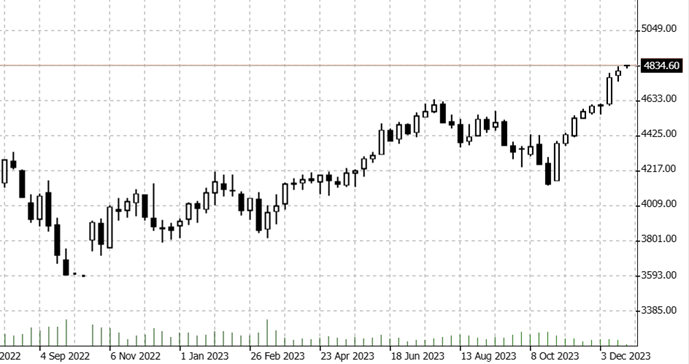

04.01.2024 – Forecasts for the coming equity year differ widely among the top names on the US financial market. We shed light on the background.
Opinions differ on the S&P 500. We think so: After the brilliant year-end rally, cashing in is probably the order of the day. Here is the weekly chart.

Quelle: Bernstein Bank GmbH
We will probably see some revisions to forecasts in the coming weeks. This is because some outlooks were delivered before the recent Santa rally.
Goldman and Citi: 5,100
Let’s start with Goldman Sachs. The upmarket address on Wall Street recently raised its target for the SPX at the end of 2024 once again – by a whopping 9 per cent from 4,700 in the previous forecast to 5,100 points.
The reason for the adjustment is the Federal Reserve’s new, dovish tone at the latest meeting and a slowdown in inflation. “Decelerating inflation and Fed easing will keep real yields low and support a price-to-earnings multiple greater than 19x,” said David Kostin, Chief US Equity Strategist. He pointed out that inflation is cooling rapidly and is approaching the Fed’s target of 2 per cent. This means that the central bank will cut interest rates much sooner than investors had previously expected. For similar reasons, Citibank also sees the SPX facing a big year for equities – with a year-end 2024 level of 5100 points as well.
JP Morgan: 4,200
JP Morgan is far more cautious: the investment bank only sees a price target of 4,200 for the S&P 500 and a “downside bias”. The analysts are by no means expecting rapid easing by the Fed. Moreover, global growth is slow, which is overshadowing the outlook for equities. There is only a moderate risk of recession for the global economy. Nevertheless, inflation will remain stubbornly above the central banks’ comfort zones. Current market expectations of an economic upturn in the industrialised countries are therefore likely to be disappointed. Weak growth and geopolitical risks are therefore weighing on equities.
Morgan Stanley: 4,500
Morgan Stanley is also among the pessimists – its target price for the SPX next December is 4,500 points. This is because Europe and the emerging markets could disappoint investors. In the USA, however, a moderate recovery in profits is set to begin. Specifically, it said: “For December 2024, we forecast a 17.0x P/E multiple on 12-month forward EPS (2025) of $266, which equates to a 4,500 price target ~12 months from today. Our 2024 earnings forecast of $229 (+7%Y) assumes 4-5%Y topline growth in addition to modest margin expansion as labour cost pressures ease.” It went on to say that the current market valuation leaves no room for error – many investors have high expectations with regard to inflation, the labour market and corporate margins.
We are excited to see how the stock market develops – we wish you successful trades and investments!
___________________________________________________________________________________________________________________________________
The content of this publication is for general information purposes only. In this context, it is neither an individual investment recommendation or advice nor an offer to purchase or sell securities or other financial products. The content in question and all the information contained therein do not in any way replace individual investor- or investment-oriented advice. No reliable forecast or indication for the future is possible with respect to any presentation or information on the present or past performance of the relevant underlying assets. All information and data presented in this publication are based on reliable sources. However, Bernstein Bank does not guarantee that the information and data contained in this publication is up-to-date, correct and complete. Securities traded on the financial markets are subject to price fluctuations. A contract for difference (CFD) is also a financial instrument with leverage effect. Against this backdrop, CFD trading involves a high risk up to the point of total loss and may not be suitable for all investors. Therefore, make sure that you have fully understood all the correlating risks. If necessary, ask for independent advice. CFDs are complex instruments and are associated with the high risk of losing money quickly because of the leverage effect. 68% of retail investor accounts lose money trading CFD with this provider. You should consider whether you understand how CFD work and whether you can afford to take the high risk of losing your money.7
